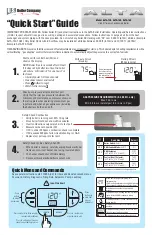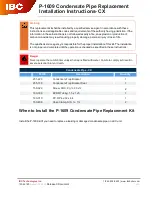
100
106375-01 - 4/16
XII. Operation
(continued)
7. Warm Weather Shutdown (WWSD)
Some boilers are used primarily for heating buildings,
and the boilers can be automatically shutdown when
the outdoor air temperature is warm. When outside air
temperature is above the WWSD setpoint, this function
will shut down the boiler, boiler and system pump.
8. Energy Management System (EMS) Interface
A factory configured RS485 Modbus interface is
available for Energy Management System (EMS)
monitoring when not used for Multiple Boiler
Sequencer Peer-To-Peer Network. Consult factory for
points list or if this interface must be used in addition
to the boiler Peer-to-Peer Network.
9. Circulator Control
The Control may be used to sequence the domestic
hot water, boiler and system circulators. Service rated
relay outputs are wired to a line voltage terminal block
for easy field connection. Simple parameter selections
allow all three pumps to respond properly to various
hydronic piping arrangements including either a boiler
or primary piped indirect water heater. Circulators may
be configured to provide the functionality of a two zone
zone panel. The system and DHW pump outputs may
be configured as one heating and one domestic or two
heating zones. Circulators are automatically run for
a 20 second exercise period after not being used for
longer than 7 days. Circulator exercise helps prevent
pump rotor seizing.
10. Multiple Boiler Sequencer Peer-To-Peer
Network
The Control includes state-of-the-art modulating lead-
lag sequencer for up to eight (8) boilers capable of auto
rotation, outdoor reset and peer-to-peer communication.
The peer-peer network is truly “plug and play”.
Communication is activated by simply connecting
a RJ45 ethernet cable between boilers. The Control
provides precise boiler coordination by sequencing
boilers based on both header water temperature and
boiler modulation rate. For example, the lead boiler
can be configured to start a lag boiler after operating
at 50% modulation rate for longer than an adjustable
time. The boilers are modulated in “unison” (parallel)
modulation rate to ensure even heat distribution.
B. Supply Water Temperature Regulation
1. Priority Demand
The Control accepts a call for heat (demand) from
multiple places and responds according to it’s “Priority”.
When more than 1 demand is present the higher priority
demand is used to determine active boiler settings.
Priority Status Screen
Display
Boiler Responding to:
1st
Sequencer
Control
The boiler is connected to the peer-
to-peer network. The boiler accepts
demand from the Sequencer Master.
2nd
Domestic Hot
Water
DHW call for heat is on and selected
as the priority demand. DHW is always
higher priority than Central Heat. It also
has higher priority than the Sequencer
Control when DHW priority is “enabled”
and “Boiler Piped” IWH is selected.
3rd
Central Heat Central Heat call for heat is on and
there is no DHW demand or DHW
priority time has expired.
4th
Auxiliary Heat Auxiliary Heat call for heat is on and
there is no Central Heat or DHW
demand. (NOTE: May be user
selected to be higher priority than
Central Heat.)
5th
Frost
Protection
Frost Protection is active and there is
no other call for heat. Frost protection
will be a higher priority than Sequencer
Control if the Sequence Master has no
active call for heat.
6th
Warm
Weather
Shutdown
(WWSD)
WWSD is active and the boiler will
not respond to central heat demands.
DHW demand is not blocked by
WWSD.
7th
Standby
There is no demand detected.
Table 12.1: Order of Priority
2. Setpoint Purpose
The Control starts and stops the boiler and modulates
the boiler input from minimum (MBH) to maximum
(MBH) in order to heat water up to the active setpoint.
The setpoint is determined by the priority (Central
Heat or Domestic Hot Water) and as described in the
following paragraphs.
3. Central Heat Setpoint
Upon a Central Heat call for heat the setpoint is
either the user entered Central Heat Setpoint, or is
automatically adjusted by Outdoor Air Reset or, an
Energy Management System (EMS) supplied setpoint.
4. Auxiliary Heat Setpoint
Auxiliary Heat is a second heating demand that may
be used to serve either lower temperature radiation
or warmer heat demands such as fan coils. Upon an
Auxiliary Heat call for heat the setpoint is either the
user entered Auxiliary Heat Setpoint or is automatically
adjusted as Outdoor Air Reset
.
For example, when Domestic Hot Water (DHW) has
priority the setpoint, “Diff Above”, “Diff Below” and
pump settings are taken from DHW selections. Active
“Priority” is displayed on the “Boiler Status” screen.
















































